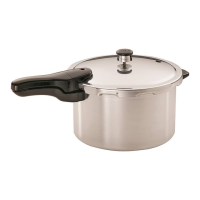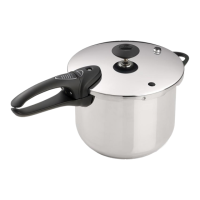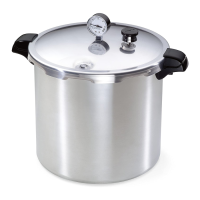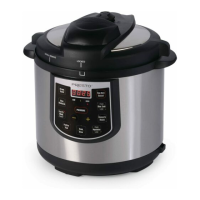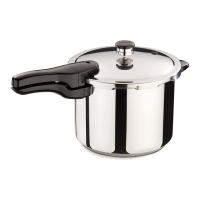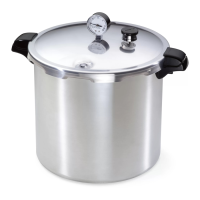22
5. WARNING! Never open the canner when it contains pressure. The air vent/cover lock provides a visual indication of pressure
inside the canner. When it is up, there is pressure. When it is down, there is no pressure in the canner and it can be opened. If the
pressure canner is opened before all of the pressure is released, the contents of the canner will erupt and could cause bodily injury
or property damage.
6. Replace the overpressure plug if it is hard, deformed, cracked, worn, or pitted, or when replacing the sealing ring. Replace
the sealing ring if it becomes hard, deformed, cracked, worn, pitted, or soft and sticky. The overpressure plug is a secondary
pressure relief valve which is designed to relieve excess pressure by releasing from the canner cover in the event that the vent pipe
becomes blocked.
The overpressure plug is made of rubber, and when new, is soft and pliable. Over time, depending on the frequency and type of use,
rubber becomes hard and inflexible. When hard and inflexible, the overpressure plug loses its ability to act as a secondary pressure
relief valve. It should be replaced immediately.
Should the overpressure plug ever be forced out of the cover due to excess pressure while cooking, it is important to call the Presto
Customer Service Department at 1-800-877-0441. Do not attempt to use the released overpressure plug.
7. Always follow special procedures found in the instruction book when pressure cooking dry beans and peas. During cooking,
dry beans and peas tend to froth and foam which could cause the vent pipe to become blocked. Therefore, dry beans and peas need
to be soaked and cooked according to instructions on page 28. Using this method will help to minimize foam during cooking.
8. Never pressure cook applesauce, cranberries, rhubarb, cereals, pasta, split peas, dried soup mixes, or dry beans and peas
which are not listed in the timetable on page 29. These foods expand so much as a result of foaming and frothing that they should
never be cooked under pressure.
HELPFUL HINTS FOR PRESSURE COOKING
Your favorite recipes may be adjusted for cooking in the canner by following the general directions in this book for the particular
type of food being cooked. Decrease the length of cooking time by two-thirds, since pressure cooking is much faster than ordinary
cooking methods. Because there is little evaporation from the canner, the amount of liquid should be decreased. Add about 2 cups
more liquid than desired in the finished product. There must always be water or some other liquid in the bottom of the canner to form
the necessary steam.
Use the cooking rack when it is desirable to cook foods out of the cooking liquid. When foods are pressure cooked out of the liquid,
flavors will not intermingle. Therefore, it is possible to cook several foods at once, as long as they have similar cooking times. If it
is desirable to blend flavors, do not use the cooking rack.
When the body of your canner is heated, the metal expands. Therefore, it may be difficult to close the cover on a heated body. When
this happens, allow canner to cool slightly.
Foods are quickly cooked in the canner. Therefore, to prevent overcooking, it is important to accurately time the cooking period.
If your cooked food has more liquid than you desire, simmer to evaporate excess liquid.
When pressure cooking at high altitudes, the cooking time needs to be increased 5% for every 1,000 feet above the first 2,000 feet.
Following this rule, the time would be increased as follows:
3,000 ft. ... 5% 4,000 ft. ... 10% 5,000 ft. ... 15% 6,000 ft. ... 20% 7,000 ft. ... 25% 8,000 ft. ... 30%
If you have questions on recipes or timetables write to: Test Kitchen, National Presto Industries, Inc., 3925 North Hastings Way, Eau
Claire, Wisconsin 54703-3703, phone 1-800-368-2194. You may also contact us at our website www.gopresto.com. Inquiries will be
answered promptly by letter, phone, or email.
PRESSURE COOKING MEAT
Savory, tender meat is easily prepared in the canner. An important step is to sear meat to a crispy brown on all sides to seal in natural
juices. Meat recipes are cooked at 15 pounds pressure. Cooking time depends on the amount and distribution of fat and bone, toughness,
size and thickness of cut, grade and cut of meat, and the manner in which the meat fits into the canner. Rolled roasts require a longer
cooking time per pound than roasts with bone. Short, chunky roasts take longer to cook than long, flat roasts. Because of the difference
in thickness, a small, thick roast requires a longer cooking time per pound than a heavier, flat roast.
After pressure cooking time is complete, serving size pieces of meat may be quick cooled. However, when cooking a roast cut of meat,
pressure must drop of its own accord to be sure that pressure is reduced both within the roast and the canner. If gravy is desired, stir 2–4
tablespoons of flour or cornstarch into ½ cup cold water. Heat liquid in canner and stir in flour mixture. Heat to boiling, stir constantly
for 1 minute or until thickened. Season with salt and pepper.
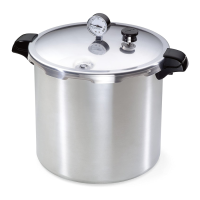
